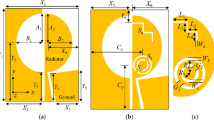Abstract
In this paper, we propose two cooperative spectrum sharing protocols for cognitive radio networks which consist of an automatic repeat request based primary user with a primary transmitter (PT) and a primary receiver (PR), and a bidirectionally communicating secondary user (SU) with two nodes, S1 and S2. PT transmits a packet to PR by accessing the spectrum alone or by the cooperation of SU or under the interference of SU in the underlay transmission, according to the acknowledgement/negative acknowledgement feedback from PR. The two protocols differ by the application of decode-and-forward and amplify-and-forward strategies at SU during cooperation. Analytical expressions are derived for the throughputs of both users for both protocols and the results are compared with the corresponding reference protocols given in the literature. The theoretical results which are in perfect match with the simulation results show the advantages of the proposed protocols.













Similar content being viewed by others
Notes
In Fig. 3, the state \({\mathcal S}_5\) moves to \({\mathcal S}_1\) with the probability \(P_1\) for the packet success and with the probability \(1-P_1\) for the packet failure.
The channels \({\hbox {PT}}\rightarrow {\hbox {S1}}\) and \({\hbox {PT}}\rightarrow {\hbox {S2}}\) have the same statistical properties similar to the channels \({\hbox {S1}}\rightarrow {\hbox {PR}}\) and \({\hbox {S2}}\rightarrow {\hbox {PR}}\). Therefore, the following calculations are for PU’s transmission over S1. The calculations for S2 can be obtained by simply replacing indice 1 with 2 in the equations.
References
Akyildiz, I. F., Lee, W.-Y., Vuran, M. C., & Mohanty, S. (2008). A survey on spectrum management in cognitive radio networks. IEEE Communications Magazine, 46(4), 40–48.
Saleem, Y., & Rehmani, M. H. (2014). Primary radio user activity models for cognitive radio networks: A survey. Journal of Network and Computer Applications, 43, 1–16.
Bukhari, S. H. R., Rehmani, M. H., & Siraj, S. (2016). A survey of channel bonding for wireless networks and guidelines of channel bonding for futuristic cognitive radio sensor networks. IEEE Communications Surveys and Tutorials, 18(2), 924–948.
Ozger, M., & Akan, O. B. (2016). On the utilization of spectrum opportunity in cognitive radio networks. IEEE Communications Letters, 20(1), 157–160.
Akan, O. B., Karli, O. B., & Ergul, O. (2009). Cognitive radio sensor networks. IEEE Network, 23(4), 34–40.
Biglieri, E., Goldsmith, A., Greenstein, L., Mandayam, N., & Poor, V. (2012). Principles of Cognitive Radio. Cambridge, UK: Cambridge University Press.
Luo, L., Zhang, P., Zhang, G., & Qin, J. (2011). Outage performance for cognitive relay networks with underlay spectrum sharing. IEEE Communications Letters, 15(7), 710–712.
Guo, Y., Kang, G., Zhang, N., Zhou, W., & Zhang, P. (2010). Outage performance of relay-assisted cognitive radio system under spectrum sharing constraints. IEEE Electronics Letters, 46(2), 182–184.
Moualeu, J. M., Hamouda, W., & Takawira, F. (2016). Performance of af relay selection with outdated channel estimates in spectrum-sharing systems. IEEE Communications Letters, 20(9), 1844–1847.
Das, P., Mehta, N. B., & Singh, G. (2015). Novel relay selection rules for average interference-constrained cognitive af relay networks. IEEE Transactions on Wireless Communications, 14(8), 4304–4315.
Luo, S., & Teh, K. C. (2015). Amplify-and-forward based two-way relay arq system with relay combination. IEEE Communications Letters, 19(2), 299–302.
Li, J. C. F., Zhang, W., Nosratinia, A., & Yuan, J. (2010). Opportunistic spectrum sharing based on exploiting ARQ retransmission in cognitive radio networks. In IEEE global telecommunications conference (GLOBECOM 2010), 2010 (pp. 1–5).
Levorato, M., Mitra, U., & Zorzi, M. (2012). Cognitive interference management in retransmission-based wireless networks. IEEE Transactions on Information Theory, 58(5), 3023–3046.
Harsini, J. S., & Zorzi, M. (2014). Transmission strategy design in cognitive radio systems with primary ARQ control and QOS provisioning. IEEE Transactions on Communications, 62(6), 1790–1802.
Michelusi, N., Popovski, P., Levorato, M., Simeone, O., & Zorzi, M. (2011). Cognitive transmissions under a primary ARQ process via backward interference cancellation. In 49th annual Allerton conference on communication, control, and computing (Allerton), 2011 (pp. 727–735).
Dawei, W., Pinyi, R., Yichen, W., Qinghe, D., & Li, S. (2015). Interference cancellation based transmission strategy using primary ARQ for cooperative CRNS. In IEEE international conference on communication workshop (ICCW), 2015 (pp. 1003–1008).
Cheng, S.-M., Ao, W. C., & Chen, K.-C. (2011). Efficiency of a cognitive radio link with opportunistic interference mitigation. IEEE Transactions on Wireless Communications, 10(6), 1715–1720.
Li, Q., Ting, S. H., Pandharipande, A., & Motani, M. (2012). Cooperate-and-access spectrum sharing with ARQ-based primary systems. IEEE Transactions on Communications, 60(10), 2861–2871.
Touati, S., Boujemaa, H., & Abed, N. (2013). Cooperative ARQ protocols for underlay cognitive radio networks. In 21st European signal processing conference (EUSIPCO 2013) (pp. 1–5).
Saraç, S., & Aygölü, Ü. (2016). An ARQ-based protocol for cooperative spectrum sharing in underlay cognitive radio networks. In IEEE international black sea conference on communications and networking (BlackSeaCom), 2016 (pp. 1–5).
Laneman, J. N., Tse, D. N. C., & Wornell, G. W. (2004). Cooperative diversity in wireless networks: Efficient protocols and outage behavior. IEEE Transactions on Information Theory, 50(12), 3062–3080.
Author information
Authors and Affiliations
Corresponding author
Rights and permissions
About this article
Cite this article
Saraç, S., Aygölü, Ü. ARQ-based cooperative spectrum sharing protocols for cognitive radio networks. Wireless Netw 25, 2573–2585 (2019). https://doi.org/10.1007/s11276-018-1686-3
Published:
Issue Date:
DOI: https://doi.org/10.1007/s11276-018-1686-3




